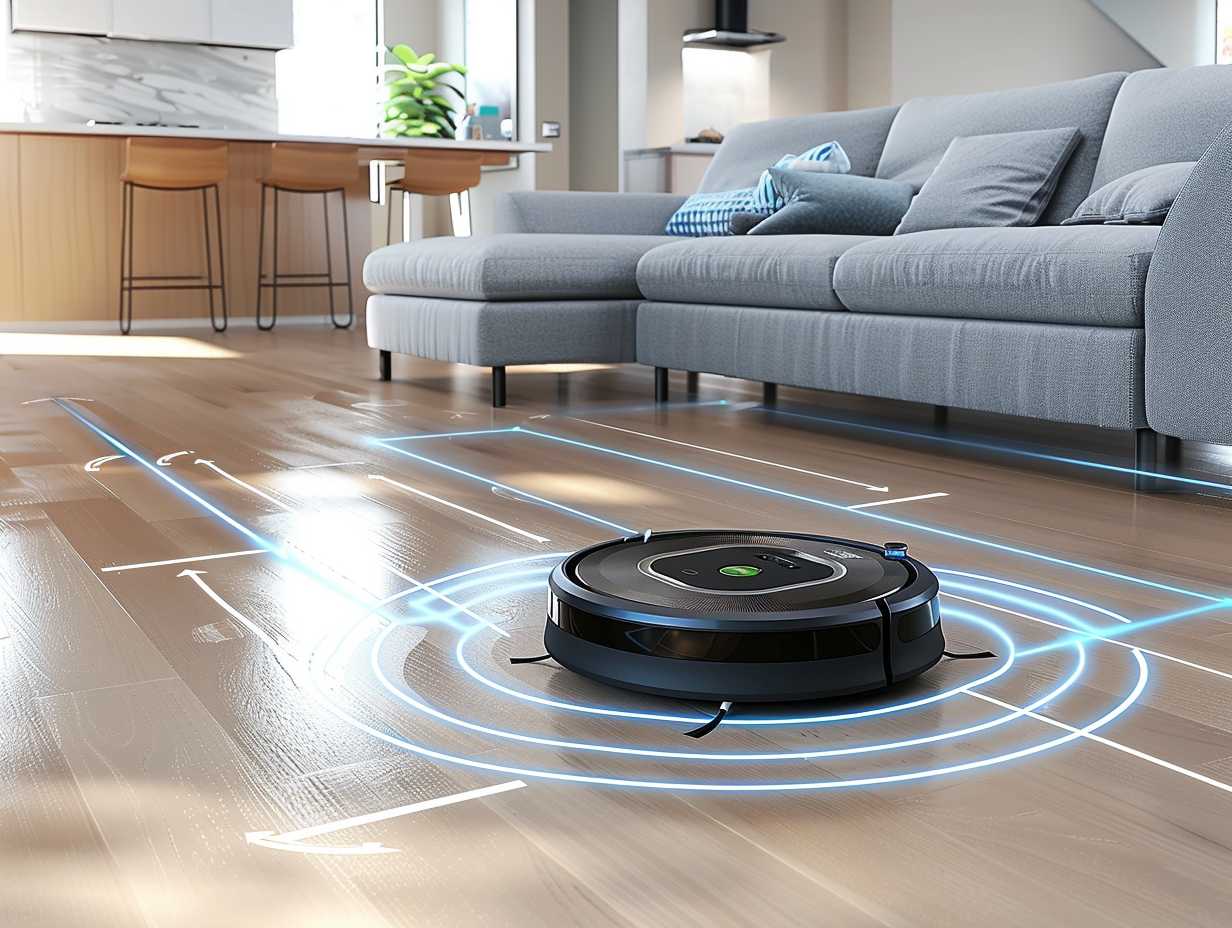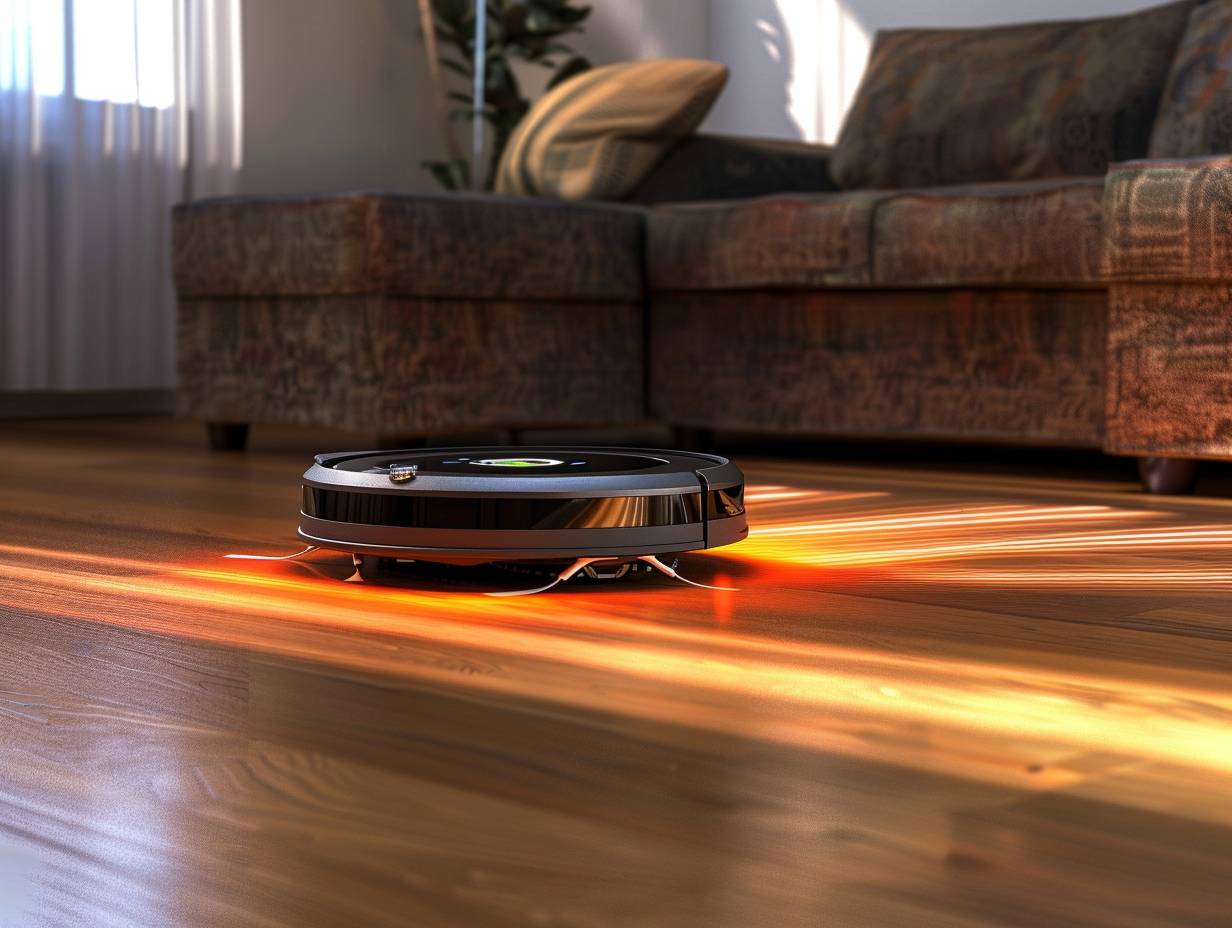
Robotic Vacuum Navigation Technologies

Imagine robotic vacuum navigation technologies as the GPS for your floors, guiding these smart devices seamlessly around your home.
But how do these robots know where to go and how to avoid obstacles? Explore the world of infrared sensors, Lidar technology, camera-based systems, SLAM, and virtual wall barriers to unravel the mystery behind their autonomous movements.
Each technology plays an essential role in ensuring efficient cleaning and preventing your robotic vacuum from getting lost or stuck.
Key Takeaways
- Infrared sensors and Lidar technology optimize obstacle detection and navigation.
- Vision-based systems enhance real-time adaptation to environment changes.
- SLAM technology enables autonomous mapping for accurate navigation in complex spaces.
- Virtual wall barriers provide customizable boundaries for efficient cleaning routines.
Infrared Sensors

When using a robotic vacuum, infrared sensors play an important role in detecting obstacles and moving through your home efficiently.
These sensors work by emitting infrared light and measuring the reflection off objects to determine their proximity. As your robotic vacuum navigates, the infrared sensors continuously scan the surroundings, ensuring a methodical and obstacle-free cleaning process.
When an object is detected, the sensors signal the vacuum to adjust its path, allowing it to maneuver around furniture, walls, and other items in its way. This technology enables your robotic vacuum to avoid collisions and efficiently clean your floors without getting stuck.
With the help of infrared sensors, your vacuum can effortlessly glide through your home, giving you a hassle-free cleaning experience.
Lidar Technology
Lidar technology enhances the robotic vacuum’s navigation capabilities by using laser sensors to create detailed maps of its surroundings. These sensors emit laser beams that bounce off objects, allowing the vacuum to measure distances accurately. The data collected is then used to generate a map that the robot uses to navigate through the space efficiently. Compared to other navigation technologies, Lidar provides a more precise representation of the environment, enabling the robot vacuum to avoid obstacles and clean more effectively.
| Lidar Technology Table | |||
|---|---|---|---|
| Pros | Cons | Examples | Usage |
| Highly accurate mapping | Expensive | Neato Botvac | Navigation |
| Efficient obstacle avoidance | Limited range | 360 Eye | Mapping |
| Works well in various lighting conditions | Complex technology | Roomba i7 | Localization |
Camera-Based Systems

Are you curious how camera-based systems are revolutionizing robotic vacuum navigation technologies? These systems use cameras to capture images of the environment, allowing the robot to navigate and clean with precision.
Here are a few key points about camera-based systems:
-
Visual Mapping: Cameras provide real-time visual data, enabling the robot to create detailed maps of the space it’s cleaning.
-
Object Recognition: Advanced algorithms analyze the images to identify obstacles, such as furniture or cords, and navigate around them efficiently.
-
Improved Navigation: By using visual cues, camera-based systems can adapt to changes in the environment, ensuring thorough cleaning and avoiding collisions.
Simultaneous Localization and Mapping (SLAM)
Simultaneous Localization and Mapping (SLAM) enhances robotic vacuum navigation by allowing the robot to autonomously create maps of its environment while determining its own position within that space. This technology is essential for ensuring efficient cleaning routes and avoiding obstacles.
SLAM works by combining data from various sensors, such as LiDAR, cameras, and wheel encoders, to build a map of the surroundings and simultaneously locate the robot within that map. By continuously updating its position relative to the map, the robot can navigate complex environments with accuracy.
SLAM algorithms enable the robot vacuum to adapt to changes in its environment, such as moving furniture or new obstacles, making it a fundamental component of advanced robotic vacuum systems.
Virtual Wall Barriers

Traversing through intricate spaces, robotic vacuums utilize Virtual Wall Barriers to establish boundaries and prevent access to specific areas. These barriers emit signals detected by the vacuum, guiding it to avoid restricted zones.
Here’s why Virtual Wall Barriers are essential for efficient cleaning:
-
Boundary Setting: Easily define where your robotic vacuum can and can’t go by placing Virtual Wall Barriers strategically.
-
Protection for Delicate Items: Safeguard fragile objects or areas like pet bowls by creating barriers around them.
-
Customizable Cleaning: Tailor your cleaning routine by blocking off certain rooms or sections with Virtual Wall Barriers, ensuring focused cleaning where needed.
Frequently Asked Questions
How Do Robotic Vacuums Handle Different Types of Flooring Surfaces, Such as Carpet, Hardwood, and Tile?
When using robotic vacuums, they automatically adjust to different flooring surfaces like carpet, hardwood, and tile. These devices employ sensors to detect surface changes and adapt their cleaning methods accordingly, ensuring effective cleaning on all types of floors.
Can Robotic Vacuums Effectively Clean Under Furniture and in Tight Corners?
Yes, robotic vacuums can effectively clean under furniture and in tight corners. Their compact design and advanced sensors enable them to navigate through narrow spaces and reach areas that traditional vacuums may struggle to access.
Are There Any Privacy Concerns With the Use of Camera-Based Systems in Robotic Vacuums?
Yes, there are privacy concerns with camera-based systems in robotic vacuums. They can inadvertently capture sensitive information. Be cautious when using devices that have cameras, ensuring your privacy and security are protected.
How Does SLAM Technology Help Robotic Vacuums Navigate and Create Maps of Their Environment?
You might wonder how slam technology aids robotic vacuums in mapping their surroundings. It allows them to navigate by constantly updating their position using sensors and algorithms, creating detailed maps as they clean.
Do Virtual Wall Barriers Have Any Limitations in Preventing Robotic Vacuums From Entering Certain Areas?
Virtual wall barriers can prevent robotic vacuums from entering specific areas by emitting signals that guide them. However, they have limitations like line-of-sight requirements and potential signal interference, which may impact their effectiveness in all situations.
Conclusion
So there you have it - robotic vacuum navigation technologies are basically like having a super-smart, ultra-efficient cleaning ninja living in your house!
With their infrared sensors, Lidar technology, camera-based systems, SLAM capabilities, and virtual wall barriers, these little machines are taking cleaning to a whole new level.
Say goodbye to dust bunnies and hello to a spotless home, all thanks to the amazing advancements in robotic vacuum navigation.
You’ll never look at vacuuming the same way again!
More information about
Affiliate information declaration: We may earn revenue from the products referred on this page and participate in affiliate programs.


